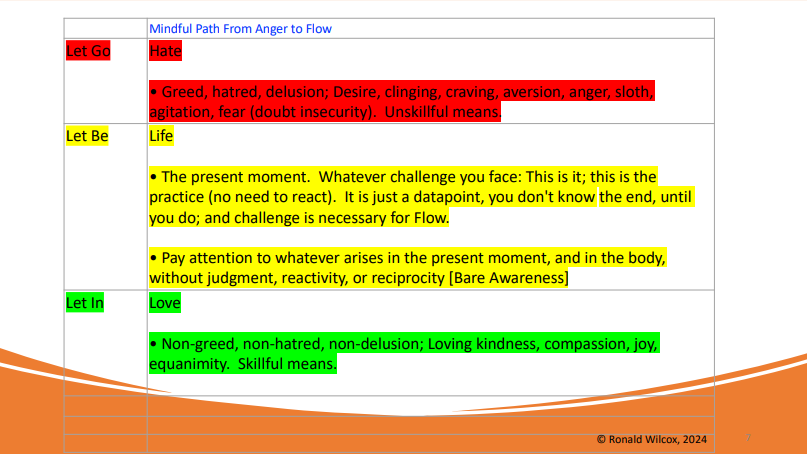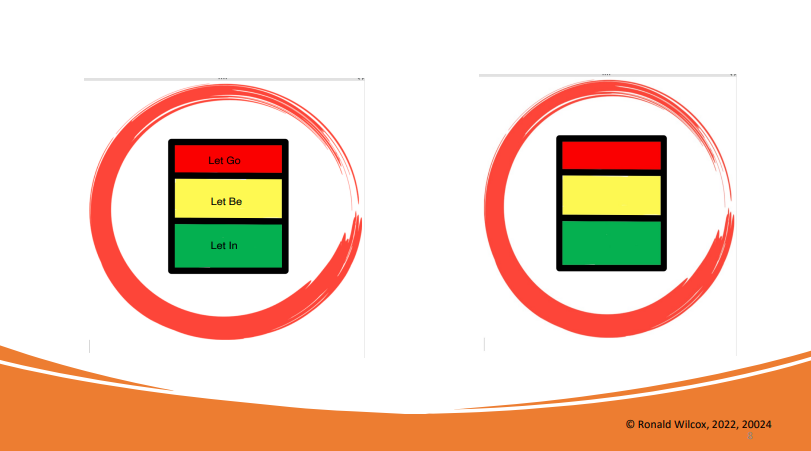The Mindful Path From Anger to Flow

I keep the images posted above my computer and return to them often. My Flow Path (the mindful path from anger to flow) works like this. Let go of hate, let be life, and let in love. The circle represents the 8 worldly winds: pleasure and pain, gain and loss, praise and blame, fame and disrepute. The question is, when they are present, will you be blown around by them, and react in knee jerk fashion, or be more mindful and respond more skillfully?
So, I walk through my progressions (each color zone), listening deeply to the body and mind, choosing deliberately how I next wish to think, act, or speak (the colorful image also serves as a helpful reminder, in the heat of the moment, when I am away from my desk).
Let Go, Hate: This is basically the hindrances, the three poisons, greed, attachment, hatred, delusion (the red zone). The bottom line is, it's all these unwholesome roots of mind, the unskillful means. So I want to let go of those as as I go through my Flow Path from anger (or whatever obstacle or hindrances arises) to flow.
Let Be Life: The present moment. Whatever challenge that you're facing, this is it. This is the practice. There's no need to react. It just is what it is right now. It's just a data point. You don't know the end until you actually do. And the challenge is actually necessary to get into flow or the zone. Scientists have explained, if you want to get into the zone, you actually need a challenge, this spark. And then what happens is, your skill will rise to the challenge, and ideally, if the challenge is 4% above your skill level, that is the ideal point where in which you'll usually raise your skill level to be able to overcome that challenge.
So, I like to look at this nowadays as if there's a challenge that I'm facing. It's not necessarily bad, it's the spark I need to get into the zone. So, when I face challenges now, I try to just pay attention to what's happening in the present moment, without any judgment, reactivity, or reciprocity. So, just notice your breath, notice your body, notice whatever challenge you are experiencing, without having to get caught up in the anger, emotions, thoughts, etc.
Let in Love: Which is just a shorthand for letting in the wholesome roots of mind, non-greed, non-hatred, non-delusion, compassion, sympathetic joy, equanimity (basically the brahma-viharas Buddha taught 2,600 years ago).
So, in the example of communicating, when I can remember and use my practice, I'll literally go through these steps of let go of hate, let be life, and let in love, before I respond to some challenge in my life, to make sure that I'm acting out of love in the green zone, and I'm not doing some knee-jerk reaction out of hate or anger or frustration, etc. I want to speak out of love and caring and not out of some kind of fear, doubt, or insecurity. Remembering whoever I am dealing with is just like me, they have had gains and losses, pleasure and pain, etc., and do what they can just to get through the day.
In sum, if all goes well, I try to not act or speak until I have reached the green zone, and then only to offer “words in kindness and for mutual benefit” (see also, Insightdialogue.org). Or put another way, acting from a place of loving kindness, compassion, sympathetic joy, and equanimity (skillful means).
Just Like Me, meditation practice
Loving Kindness, meditation practice
Insight Dialogue, meditation practice
Other Helpful Resources
1. Leonard R. Riskin, The Contemplative Lawyer: On The Potential Contributions Of Mindfulness Meditation To Law Students, Lawyers, And Their Clients, 7 Harv. Negotiation L. Rev. 1 (2002), available here.
2. Tatiana Posada, How Mindfulness Changed My Life: A Law Student’s Story (Apr. 27, 2018), available here.
3. Charity Scott, Mindfulness in Law: A Path to Well-Being and Balance for Lawyers and Law students, 60 Ariz. L. Rev. 635 (2018),available here.
4. David M. Zlotnik, Integrating Mindfulness and Theory Into Trial Advocacy, Journal of Legal Education, 61 J. Legal Educ. 654 (2012), available here.
5. Gregory Kramer, Meditating Together, Speaking From Silence: The Practice of Insight Dialogue (2003),available here.
6. Gregory Kramer, Florence Meleo Meyer, and Martha Lee Turner, Cultivating Mindfulness in Relationship: Insight Dialogue And The Interpersonal Mindfulness Program, in Mindfulness And The Therapeutic Relationship, at 195 (2008), available here.
7. Tania Perlin, Mindful Communication (blogpost regarding The Art of Communicating), available here.
8. The Art of Communicating: Mastering Life's Most Important Skill Through Mindfulness, Personal Growth, and Effective Interpersonal Relations with Zen Master Thich Nhat Hanh (2014), available here.
9. Michael Leizerman, with Jay Rinsen Weik, The Zen Lawyer: Winning With Mindfulness (2018), available here.
10. Pema Chodron, Holding Your Seat When The Going Gets Rough, available here.
11. George Mumford, The Mindful Athlete: Secrets To Pure Performance (2015), available here.

